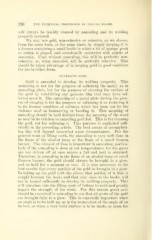Page 494 - My FlipBook
P. 494
230 THE TECHNICAIi PBOCEDTJRES IN FILLING TEETH.
will always be readily cleaned by annealing and its welding
property restored.
We may use gold, non-cohesive or cohesive, as we choose,
from the same book, or the same sheet, by simply keeping it in
a drawer containing a small bottle in which a bit of sponge, punk
or cotton is placed, and occasionally saturated with spirits of
ammonia. Used without annealing, this will be perfectly non-
cohesive, or, when annealed, will be perfectly cohesive. This
should be taken advantage of in keeping gold in good condition
for use in either form.
ANNEALING GOLD.
Gold is annealed to develop its welding property. This
annealing is not for the purpose of softening the metal, as in
annealing plate, but for the purpose of cleaning the surface of
the gold by volatilizing any gaseous film that may have col-
lected upon it. The annealing of a metal plate during the proc-
ess of swaging is for the pur^jose of softening it or restoring it
to its former condition of softness which has been lost by the
violence used in hammering or bending it. This meaning of
annealing should be held distinct from the meaning of the word
as used in its relation to annealing gold foil. This is for cleaning
the gold, not for softening it. This purpose is explained suffi-
ciently in the preceding article. The best means of accomplish-
ing this will depend somewhat upon circiunstances. For the
general work of filling teeth, the annealing is very well done in
the flame of the alcohol lamp or the flame of a small Bunsen
burner. The element of time is important in annealing, particu-
larly if the annealing is done at low temperatures, for the gases
are not driven off at once unless a full red heat is obtained.
Therefore, in annealing in the flame of an alcohol lamp or small
Bunsen burner, the gold should always be brought to a glow,
and so held for a moment or two. It is also necessary to the
best results that every particle of the gold be brought to a glow.
In taking up the gold with the jjliers, that portion of it that is
caught between the beaks and that very close to the beaks, will
not be heated sufficiently to develop its welding iiroperty. This
will introduce into the filling spots of failure to weld and greatly
impair the strength of the work. For this reason great care
should be exercised in annealing to see that all parts of the gold
are brought fully to a glow. This is especially important when
an angle is to be built up, as in the restoration of the angle of an
incisor, or when a very solid surface is to be made, as upon the


